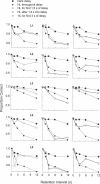Reversing the course of forgetting
- PMID: 21909163
- PMCID: PMC3168886
- DOI: 10.1901/jeab.2011.96-177
Reversing the course of forgetting
Abstract
Forgetting functions were generated for pigeons in a delayed matching-to-sample task, in which accuracy decreased with increasing retention-interval duration. In baseline training with dark retention intervals, accuracy was high overall. Illumination of the experimental chamber by a houselight during the retention interval impaired performance accuracy by increasing the rate of forgetting. In novel conditions, the houselight was lit at the beginning of a retention interval and then turned off partway through the retention interval. Accuracy was low at the beginning of the retention interval and then increased later in the interval. Thus the course of forgetting was reversed. Such a dissociation of forgetting from the passage of time is consistent with an interference account in which attention or stimulus control switches between the remembering task and extraneous events.
Keywords: delayed matching to sample; forgetting functions; pigeons; remembering; retroactive interference; short-term memory.
Figures




Similar articles
-
In search of consolidation of short-term memory in nonhuman animals.Learn Behav. 2014 Mar;42(1):83-92. doi: 10.3758/s13420-013-0127-5. Learn Behav. 2014. PMID: 24233886
-
Reversing the signaled magnitude effect in delayed matching to sample: delay-specific remembering.J Exp Anal Behav. 2011 Jul;96(1):7-15. doi: 10.1901/jeab.2011.96-7. J Exp Anal Behav. 2011. PMID: 21765543 Free PMC article.
-
Direct remembering, mediated remembering, and atypical forgetting functions.J Exp Anal Behav. 2018 Jan;109(1):70-86. doi: 10.1002/jeab.298. Epub 2018 Jan 2. J Exp Anal Behav. 2018. PMID: 29293263
-
Timing, memory for intervals, and memory for untimed stimuli: the role of instructional ambiguity.Behav Processes. 2005 Nov 1;70(3):209-22. doi: 10.1016/j.beproc.2005.07.001. Behav Processes. 2005. PMID: 16095851 Review.
-
Memory procedures, performance and processes in pigeons.Brain Res Cogn Brain Res. 1996 Jun;3(3-4):309-17. doi: 10.1016/0926-6410(96)00016-x. Brain Res Cogn Brain Res. 1996. PMID: 8806032 Review.
Cited by
-
A delay-specific differential outcomes effect in delayed matching to sample.Learn Behav. 2015 Sep;43(3):217-27. doi: 10.3758/s13420-015-0174-1. Learn Behav. 2015. PMID: 25784485
-
In search of consolidation of short-term memory in nonhuman animals.Learn Behav. 2014 Mar;42(1):83-92. doi: 10.3758/s13420-013-0127-5. Learn Behav. 2014. PMID: 24233886
References
-
- Barrouillet P, Bernardin S, Camos V. Time constraints and resource sharing in adults' working memory spans. Journal of Experimental Psychology: General. 2004;133:83–100. - PubMed
-
- Brown G.D.A, Lewandowsky S. Forgetting in memory models. In: Salla S.D, editor. Forgetting. Hove, Sussex: Psychology Press; 2010. pp. 49–75. (Ed.)
MeSH terms
LinkOut - more resources
Full Text Sources

